How can I add a colorbar scale to the 2nd & 3rd subplots, such that it is inline with my legends in the 1st and 4th subplots? Or, another way to say the question: how can I add a colorbar scale without changing the alignment/justification of the 2nd & 3rd subplots?
There are good examples available on setting colorbar locations (e.g., here on stackoverflow and in the matplotlib docs), but I still haven't been able to solve this.
Below is a reproducible example. The real data are more complicated, and this is part of a loop to produce many figures, so the "extra" stuff about setting axis limits and subplot aspect ratios is needed and will change with different datasets.
Using Python 3.8.
Reproducible example without colorbar
## Specify axes limits, tick intervals, and aspect ratio
xl, yl, xytick, ar = [-40000,120000], [-30000,10000], 20000, 0.8
## Global plot layout stuff
fig = plt.figure(figsize=(10, 7.5), constrained_layout=True)
gs = fig.add_gridspec(4, 1)
ax1 = fig.add_subplot(gs[0, 0])
ax2 = fig.add_subplot(gs[1, 0], sharex = ax1, sharey = ax1)
ax3 = fig.add_subplot(gs[2, 0], sharex = ax1)
ax4 = fig.add_subplot(gs[3, 0], sharex = ax1, sharey = ax3)
fig.execute_constrained_layout()
fig.suptitle('Suptitle')
## First Plot
ax1.plot([-30000, 500], [-2000, -21000], c='red', label='A')
ax1.plot([80000, 110000], [-9000, 800], c='blue', label='B')
ax1.set_title('ax1', style='italic');
ax1.set_xlabel('x');
ax1.set_ylabel('beta');
ax1.set_xlim(xl)
ax1.set_ylim(yl)
ax1.xaxis.set_major_locator(ticker.MultipleLocator(xytick))
ax1.yaxis.set_major_locator(ticker.MultipleLocator(xytick))
ax1.legend(handles=leg, bbox_to_anchor=(1.05, 1), loc='upper left')
ax1.set_aspect(aspect=ar)
## Dummy data for plots 2/3/4
x = [-15000, -2000, 0, 5000, 6000, 11000, 18000, 21000, 25000, 36000, 62000]
beta = [1000, 200, -800, 100, 1000, -2000, -5000, -5000, -15000, -21000, -1500]
y = [0.01, 0.2, 1.3, 0.35, 0.88, 2.2, 2.5, 1.25, 3.4, 4.1, 2.1]
## Second Plot
vals = ax2.scatter(x, beta, c=y, norm=mcolors.LogNorm(), cmap='rainbow')
ax2.set_title('ax2', style='italic');
ax2.set_xlabel('x');
ax2.set_ylabel('beta');
ax2.set_aspect(aspect=ar)
## Attempt to add colorbar
#cbar = fig.colorbar(vals, ax=ax2, format = '%1.2g', location='right', aspect=25)
#cbar.ax.set_ylabel('y')
#cbar.ax.yaxis.set_label_position('left')
#cbar_range = [min(y), max(y)]
#ticklabels = cbar.ax.get_ymajorticklabels()
#cbarticks = list(cbar.get_ticks())
#cbar.set_ticks(cbar_range + cbarticks)
## Third Plot
ax3.scatter(x, y, c=y, norm=mcolors.LogNorm(), cmap='rainbow')
ax3.set_title('ax3', style='italic');
ax3.set_xlabel('x');
ax3.set_ylabel('y');
ax3.yaxis.set_major_formatter(FormatStrFormatter('%1.2g'))
## Fourth Plot
ax4.scatter(x, y, c='black', label='Dots')
ax4.set_title('ax4', style='italic');
ax4.set_xlabel('x');
ax4.set_ylabel('y');
ax4.legend(bbox_to_anchor=(1.05, 1), loc='upper left')
## Clean-up, set aspect ratios
figW, figH = ax1.get_figure().get_size_inches()
_, _, w, h = ax1.get_position().bounds
disp_ratio = (figH * h) / (figW * w)
data_ratio = sub(*ax3.get_ylim()) / sub(*ax3.get_xlim())
ax3.set_aspect(aspect=disp_ratio / data_ratio )
ax4.set_aspect(aspect=disp_ratio / data_ratio)
## Clean-up, turn axis ticks back on after messing with cbar
#ax1.tick_params(axis='both', which='both', labelbottom='on')
#ax2.tick_params(axis='both', which='both', labelbottom='on')
#ax3.tick_params(axis='both', which='both', labelbottom='on')
Result when trying colorbar, note misalignment of second plot





